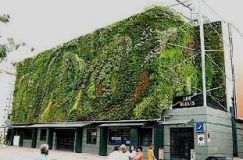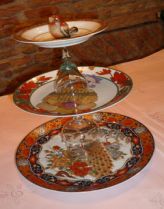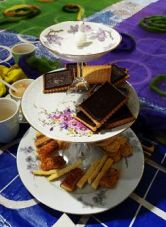A Florish of Vertical Garden Green
Ever more new creative systems
 Rooftop gardens are growing in numbers and size in many cities. But walls, too (both in- and outside) can be converted into gardens, using new technologies!
Rooftop gardens are growing in numbers and size in many cities. But walls, too (both in- and outside) can be converted into gardens, using new technologies!
The rapidly evolving practical sciences of hydroponics (or aquaponics) have spurred exciting urban phenomena like rooftop gardens, rooftop agriculture and, most recently, the art of ‘wall gardening’. Hydroculture is the growing of plants on artificial substrates or directly in fertile liquids.
So far, three vertical garden systems dominate the market. The oldest and by far most famous one is Patrick Blanc’s Mur Végétal (Vegetation Wall). Younger are the Dutch WonderWall and the Japanese-Singaporese Parabienta Green Wall.
Blanc’s free paterns
Since 1988, the French botanist and landscape architect Partick Blanc, originally a specialist in tropical forest vegetation, has created imposing wall gardens, both on official and commercial buildings and in private homes, all over the world.
Blanc’s system consists of a steel frame, screwed into the wall, on which are mounted layers of PVC and non-corrosive and water absorbing felt. Irrigation is fully automated. Freely choosing his artistic patterns, Blanc stuffs his plants in small pockets, cut out into the felt tapestry.
WonderWall
Nice, but imperfect, judged the Copijn Landscaping Architects in Utrecht (the Netherlands). Blancs system requires intensive maintenance, yet relatively many plants die. The Dutch designed the WonderWall.
It is “more robust”, Copijn claims, but it appears a less flexible, as the planting pockets are placed at precisely regular intervals. Both outdoor and intoor applications are possible. In Amsterdam Mercator Plaza Sports Center outer walls have been decked with WonderWall green, as has the interior of Antwerp’s Fragile fashion store.
Asian Green Wall
The Japanese Shimizu Building Corp’s Parabienta Green Wall is a clicking system, a mosaic of square modules, anchored to the wall. Each module consists of a spongy irrigating tissue, for which earth and polyester that have been heated and ‘molten’ into a new type of fabric.
With the National University of Singapore, Shimizu developed a ‘tropics version’, as well. In the tropics, vertical gardens, like rooftop gardens serve to cool buildings. In the sun, the temperature on bare outer walls can rise to 58 ° centigrade. Singapore’s Changi International Airport arrival hall boasts todays world’s most spectacular Parabienta Wall.
www.murvegegatalpatrickblanc.com
www.copijn.nl/copp/wonderwall.html
Martial Art

Once they were bullets, pistols or grenades. Now under the deft hands of Mozambique’s possibly most famous sculptor Goncalo Mabunda they have been transformed into Art.
Recycling AK-47's and other arms from the one-time civil war has become the trade mark of Mabunda and a couple of his fellow artists. I saw some of the results in a small B&B in Antwerp. But even the British Museum and the Bill Clinton Foundation acquired pieces from the 'Arms into Art' programme. Read more…
Photo: © Michel Robles
High on FSC

Ten years ago the Netherlands were an admired environmental pioneer nation. Nowadays, due to a shortsighted neoliberal policy we are almost tail-end Charley within the European Union. Belgium, on the other hand, is a real runner-up. Last December (2010) the Flemish Leukenheide distillery presented Dennenknopje (Pine Bud). Dennenknopje is the world’s very first jenever (traditionally a truly Dutch strong drink), made from a Forest Stewardship Council (FSC) labeled wood product. The gin-like softbooze is distilled from pine cones from the Pinus silvestris. The pines grow in Flanders’ vastest, FSC certified forest region Bosland. A local high from an okay forest. Innovation can be anywhere.…
Questioning Plastiki pride
The newly designed cradle-to-cradle catamaran Plastiki has recently arrived is Sidney after a publicity voyage from California across the Pacific Ocean. The designers claim extreme recyclability. But, contrary to earlier announcements, the ship will not be up-cycled now that it has reached its destination. The builders say they've become too attached to their newborn baby. Of course, the vessel can be a showcase for years to come. But, hey, isn't this kind of attachment of people to their achievements precisely the reason why our earth is becoming such a cluttered place? www.theplastiki.com

Sweet C2C
Cradle-to-cradle handmade beauty: go haunt the town's antique and recycle shops and flea markets for a bunch of elegant (or maybe you prefer funny or modern design) plates, saucers and wine glasses. Wash them well, sand the glasses' brims lightly and glue things together with strong porcelain glue. Any shape, size and design you fancy, will do.


Lo and behold: you have now created your own home grown bonbonnière! For sweets, cookies, fruit - or sandwiches if you like. Ladies love'em! Dozens were sold in a fashion shop in my home town. Enjoy more...

Photos: © Michel Robles
Links
Novio Design Webdesign
